The anti-drone weapons market is projected to grow from USD 1.8 billion in 2025 to USD 11 billion by 2035, reflecting a CAGR of 20%. This rapid growth is driven by the increasing need for countermeasures against the rising threat of unmanned aerial vehicles (UAVs) in both military and civilian applications. Anti-drone weapons, which include jamming systems, directed energy weapons, and kinetic interceptors, are becoming increasingly crucial for national security, public safety, and critical infrastructure protection. The growing use of drones for surveillance, smuggling, and potential terrorist activities has accelerated the demand for effective countermeasures.
As drone technology evolves, anti-drone systems are also becoming more sophisticated, incorporating AI, machine learning, and sensor fusion for real-time identification and mitigation of UAV threats. The defense and security sectors are expected to remain the primary drivers for market expansion, with growing investments in defense infrastructure and counter-UAV systems by governments worldwide. Additionally, the increasing adoption of drones in commercial applications and recreational use will further fuel demand for anti-drone weapons as these sectors seek to mitigate potential risks associated with UAV operations. The market is also bolstered by technological advancements in non-lethal countermeasures and cost-effective solutions for various defense needs.
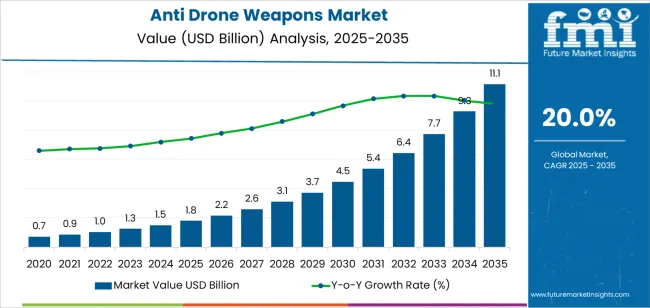
The Rolling CAGR analysis allows for a closer look at the year-over-year growth of the anti-drone weapons market and helps provide insight into the market's acceleration or deceleration in different periods throughout the forecast. For the period 2025-2035, the market's overall CAGR is 20%, but this growth will likely vary year by year, especially during the early and later years of the forecast.
Between 2025 and 2030, the market will see an initial higher CAGR as the demand for anti-drone technologies accelerates. In this phase, government investments in national defense and civilian security systems will lead to a strong increase in demand. The CAGR during this phase might range from 22% to 25% as new counter-drone solutions hit the market and more applications emerge. Over the next five years, from 2030 to 2035, the CAGR will stabilize slightly but remain strong, ranging between 15% to 18%. This will be a more mature phase where anti-drone systems have reached broader market penetration, but competition and advancements in technology will continue to support growth. The steady evolution of counter-drone systems and increased regulatory adoption globally will help maintain the market's trajectory towards the USD 11 billion milestone by 2035.
The rolling CAGR analysis highlights that, although the market may experience fluctuations in growth rates, the overall trend remains robust, supported by a constant drive for technological advancement and the increasing need for protection against drone-related threats. The high growth potential in the early stages of the forecast provides a favorable outlook for stakeholders involved in the anti-drone weapons market.
| Metric | Value |
|---|---|
| Market Value (2025) | USD 1.8 billion |
| Market Forecast Value (2035) | USD 11 billion |
| Forecast CAGR (2025-2035) | 20% |
The anti-drone weapons market is growing in response to the increasing use of unmanned aerial vehicles (UAVs) for intrusion, espionage, smuggling, and even attacks on personnel and infrastructure. Governments and defense organizations are allocating more funding to develop counter-UAV systems aimed at protecting airports, military bases, borders, and critical infrastructure. This has spurred demand for hardware and software solutions that can detect, track, and disable hostile drones. Systems such as radar detection, signal jamming, and directed energy weapons are gaining traction as the drone threat spectrum expands both in military and civilian contexts.
Another driver is technological advancement combined with regulatory pressure. As drones become more accessible and capable, the need for layered defense systems has become more urgent. Suppliers are increasingly offering integrated packages combining sensors, electronic warfare tools, and kinetic interceptors. Meanwhile, many jurisdictions are strengthening frameworks for drone regulation and the requirement of counter-UAV protection in sensitive zones, creating new procurement mandates for anti-drone weapons.
The anti-drone weapons market is segmented by weapon platform type and application. The ground-mounted platform type leads, with a market share of 50%, while the military application segment holds the dominant position at 65%. These two sub-segments play a central role in the market's growth, driven by increasing concerns over drone threats in defense and national security, as well as the evolving demand for effective counter-drone solutions across various sectors.
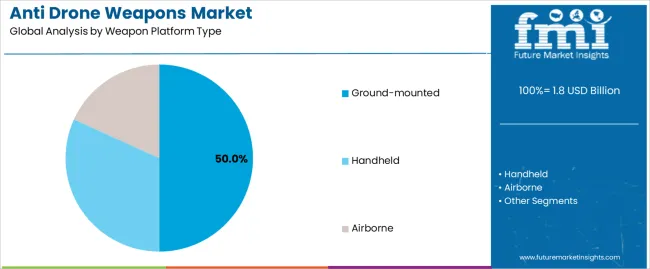
The ground-mounted weapon platform leads the anti-drone weapons market with a 50% share. Ground-mounted systems are typically preferred in both military and civil applications due to their stability, long-range capabilities, and enhanced targeting accuracy. These systems are often deployed in fixed locations or vehicles, providing a reliable and strategic defense against unauthorized drones. The ability to continuously monitor and neutralize threats from a stationary or mobile ground position makes ground-mounted systems an essential tool in securing sensitive areas, military installations, and critical infrastructure.
The widespread adoption of ground-mounted anti-drone systems is supported by the increasing need for perimeter security in various sectors, particularly in military applications where safeguarding borders and defense installations is a top priority. Additionally, ground-mounted platforms are highly effective in urban environments, where drones pose significant risks to public safety and security. As the threat from drones continues to grow globally, the demand for ground-mounted anti-drone systems is expected to remain strong, reinforcing its leadership in the market.
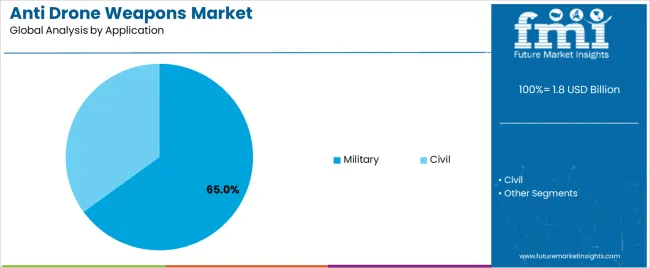
The military application segment dominates the anti-drone weapons market, accounting for 65% of the total market share. Military forces worldwide are increasingly deploying counter-drone technologies to protect against the threat posed by adversarial drones, particularly in conflict zones and border areas. The growing sophistication of drone technology has led to the development of advanced anti-drone weapons capable of neutralizing both small commercial drones and large, high-end military UAVs. These weapons are used to protect military bases, airfields, and strategic assets from aerial threats.
The dominance of the military sector is driven by rising security concerns, technological advancements in drone capabilities, and the increasing use of drones in surveillance, reconnaissance, and even weaponized forms. As the need for defense against these aerial threats grows, military forces are investing heavily in anti-drone systems, including both ground-mounted and handheld devices. This segment is expected to continue leading the market as governments and defense organizations prioritize securing their airspace and developing effective countermeasures against drone-related risks.
The anti-drone weapons market is witnessing notable expansion owing to the increasing deployment of unmanned aerial vehicles (UAVs) for both civilian and malicious purposes, prompting defense and security stakeholders to invest in systems capable of detection, tracking, and neutralization. The market size is projected to grow substantially. Key drivers include rising government defense budgets, regulatory mandates for drone airspace protection, and technological advancements in sensors and counter-drone weapons. Simultaneously, the market contends with high system costs, evolving drone counter-measures, and integration challenges across legacy defense systems. Emerging trends such as artificial intelligence integration and multi-sensor fusion underpin future growth prospects.
Several forces underpin growth in the anti-drone weapons market. First, the growing availability and lowered cost of drones allow non-state actors and adversaries to deploy swarms or autonomous UAVs, increasing the threat environment and prompting the purchase of counter-UAV systems. Secondly, major defense programs and infrastructure security demands, such as for airports, critical infrastructure, and border zones, are pushing investments into detection and weaponization of counter-drone capabilities. Third, technological advancements in hardware like radar, RF sensors, and laser weapons, along with software improvements in AI-based threat recognition, are enhancing system capabilities and broadening application scopes. These drivers combine to accelerate adoption of anti-drone weapons across military, homeland security, and commercial segments.
Despite growth potential, the anti-drone weapons market faces several constraints. Investment costs for advanced counter-drone weapons remain high, which may limit uptake among smaller jurisdictions or less-well-funded organizations. The need to integrate new systems into existing defense infrastructure and ensure interoperability across detection and neutralization layers presents logistical and technical obstacles. Additionally, drone operators continuously develop counter-measures, such as stealth, swarming, and jamming, which can undermine existing systems and create a moving target for manufacturers and buyers. Regulatory and legal issues around deploying weaponized systems in civilian airspace, along with concerns about collateral damage and misuse, may also delay deployment. These factors may slow adoption in some segments or geographies.
Several trends are shaping the future of anti-drone weapons. A prominent trend is the integration of AI and machine learning to improve detection, classification, and automated decision-making in multi-sensor arrays like radar, RF, and optical systems. Another trend is the growth of directed energy weapons, such as lasers and microwaves, as alternatives or supplements to kinetic systems, enabling lower cost per engagement and reduced logistics for ammunition. Portability and modularity are gaining importance, with handheld or vehicle-mounted systems designed for rapid deployment in urban or border environments. Finally, the convergence of defense and commercial use-cases, such as airport security, large events, and critical infrastructure, is expanding the addressable market beyond traditional military buyers.
The anti-drone weapons market is experiencing rapid growth as nations around the world face increasing security challenges related to drone technology. These threats include the use of drones for terrorism, smuggling, espionage, and other illicit activities. As a result, there is a growing demand for anti-drone systems that can effectively neutralize threats in both military and civilian contexts. Countries like China and India are leading the market due to their large defense sectors, growing investments in defense technologies, and security concerns.
Developed markets like the USA and Germany are also witnessing steady growth driven by advancements in defense technology and increased military spending. This analysis explores the key factors influencing the growth of the anti-drone weapons market in different countries, highlighting regional variations and trends.
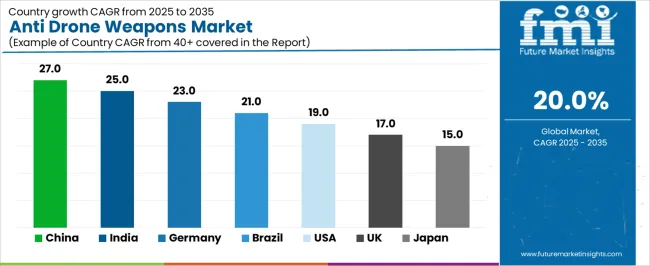
| Country | CAGR (2025-2035) |
|---|---|
| China | 27% |
| India | 25% |
| Germany | 23% |
| Brazil | 21% |
| USA | 19% |
| United Kingdom | 17% |
| Japan | 15% |
China is leading the anti-drone weapons market with an impressive CAGR of 27.0%. The country’s rapid advancements in defense technology, along with rising concerns over national security, are the primary drivers of this growth. China’s defense sector is growing significantly as the government invests in cutting-edge technologies, including anti-drone systems, to secure its borders, critical infrastructure, and military assets from potential threats posed by drones.
China has faced increasing concerns over the use of drones by adversaries for espionage, surveillance, and even as potential tools of warfare. This has prompted significant investments in the development of counter-drone systems. Moreover, China's large-scale industrial manufacturing base, coupled with an increasing focus on modernizing its military capabilities, positions the country as a leader in the anti-drone weapons market. As security challenges related to drones escalate globally, China’s dominance in this market is expected to continue.
India is experiencing strong growth in the anti-drone weapons market, with a CAGR of 25.0%. The country’s growing defense budget, heightened security concerns, and increasing investment in technological innovations are the key drivers behind this growth. India’s defense sector is increasingly prioritizing counter-drone technologies to protect critical infrastructure, military installations, and borders from potential drone-based threats.
India's proximity to regions with ongoing security challenges, along with its military modernization programs, is fueling the demand for anti-drone systems. Furthermore, the country's interest in enhancing its air defense capabilities, as well as protecting against surveillance and espionage drones, makes anti-drone weapons a key component of its defense strategy. As India continues to invest in advanced defense technologies, the anti-drone weapons market is expected to see significant growth.
Germany’s anti-drone weapons market is projected to grow at a CAGR of 23.0%. As one of Europe’s leading defense markets, Germany is investing heavily in advanced defense technologies, including anti-drone systems. The country’s strong emphasis on securing its borders, military facilities, and critical infrastructure from drone-based threats has prompted the increased development and adoption of counter-drone solutions.
Germany’s defense sector is focusing on the integration of new technologies, such as radar and electronic warfare systems, to detect and neutralize drone threats. Additionally, the rise in terrorism concerns and the need for protection against surveillance drones are contributing factors to Germany's market growth. With continued investments in defense research and development, Germany’s anti-drone weapons market is poised for steady growth in the coming years.
Brazil’s anti-drone weapons market is expected to grow at a CAGR of 21.0%. Brazil’s expanding defense capabilities, coupled with increasing concerns over drone-related security threats, are driving demand for anti-drone systems. As the country modernizes its military and defense infrastructure, the need for advanced technologies, including drone countermeasures, is becoming more apparent.
Brazil’s focus on securing its borders, protecting large-scale infrastructure projects, and enhancing its security operations is contributing to the growth of the anti-drone market. The country's increasing involvement in international peacekeeping and defense operations is also pushing demand for technologies that can protect against drone threats. With growing investments in defense technology, Brazil is expected to see continued growth in its anti-drone weapons market.
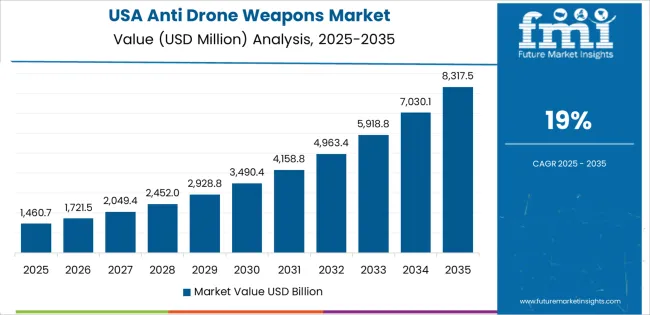
The United States has a projected CAGR of 19.0% for the anti-drone weapons market. As a global leader in defense and security technologies, the USA is actively investing in counter-drone systems to address the growing threats posed by drones. The military, law enforcement, and private sector are all adopting anti-drone solutions to safeguard critical infrastructure, national security, and public safety.
The USA has been at the forefront of developing advanced technologies such as jamming systems, directed energy weapons, and autonomous drones for counteracting drone threats. With the increasing use of drones for surveillance, smuggling, and terrorism, the USA government is prioritizing anti-drone technologies. As military and civilian applications for anti-drone systems expand, the market is expected to continue its steady growth.
The United Kingdom’s anti-drone weapons market is projected to grow at a CAGR of 17.0%. The UK government has made significant investments in counter-drone technologies in response to growing concerns about drone threats to national security, critical infrastructure, and public safety. The need to protect airports, military installations, and key urban areas from drone intrusions is a major driver of market growth.
The UK’s defense sector is actively developing and deploying various countermeasures, including radar systems, electronic jammers, and interceptor drones. As the country continues to invest in both military and civilian security infrastructure, the demand for anti-drone systems will remain strong. The growing sophistication of drone threats and the UK’s commitment to maintaining a strong defense posture ensure that the market for anti-drone weapons will continue to grow.
Japan’s anti-drone weapons market is expected to grow at a CAGR of 15.0%. Japan, like many other countries, is facing increasing concerns about the use of drones for terrorism, surveillance, and unauthorized access to sensitive areas. The country’s active defense sector, along with its focus on technological innovation, is driving the adoption of anti-drone systems.
Japan’s growing interest in securing airports, military facilities, and critical infrastructure from potential drone-based threats has resulted in the development of effective countermeasures. The country’s focus on advanced technology and its strategic defense alliances further contribute to the market’s growth. As Japan continues to enhance its national security posture and invest in defense technologies, the demand for anti-drone weapons is expected to see steady growth.
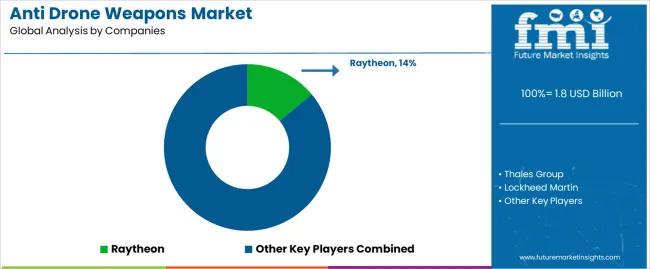
The anti-drone weapons market is witnessing significant growth, driven by the increasing need for security against unauthorized drones in both military and civilian environments. Key players in this market include Raytheon, which holds a 14% share, as well as Thales Group, Lockheed Martin, CETC, Teledyne FLIR, Saab, HENSOLDT, RADA, Echodyne, Robin Radar Systems, Blighter, Chengdu Aircraft Technology Co., Ltd., DroneShield, Raydaen, and Shenzhou Mingda. These companies are actively engaged in developing advanced technologies to counter the growing threat posed by drones, such as electronic warfare systems, radar systems, and jamming technologies. The market is also fueled by concerns related to drone-related threats in areas such as airports, military bases, and critical infrastructure.
Companies in the anti-drone weapons market are competing through technology development and strategic partnerships. Some focus on enhancing the precision and effectiveness of their jamming systems, while others are developing radar-based detection systems that can track drones at greater distances. Many of the companies, including Raytheon and Lockheed Martin, are integrating artificial intelligence and machine learning into their products to improve real-time detection and response.
Additionally, firms are expanding their geographical reach, with growing demand from defense sectors in regions like North America, Europe, and the Asia-Pacific. With the market’s expansion, companies are increasingly focusing on improving product reliability and adaptability to different environments, aiming to provide comprehensive anti-drone solutions to both military and civilian customers.
| Items | Details |
|---|---|
| Quantitative Units | USD Billion |
| Regions Covered | Asia Pacific, Europe, North America, Latin America, Middle East & Africa |
| Weapon Platform Type | Ground-mounted, Handheld, Airborne |
| Application | Military, Civil |
| Key Companies Profiled | Raytheon, Thales Group, Lockheed Martin, CETC, Teledyne FLIR, Saab, HENSOLDT, RADA, Echodyne, Robin Radar Systems, Blighter, Chengdu Aircraft Technology Co., Ltd., DroneShield, Raydaen, Shenzhou Mingda |
| Additional Attributes | The market analysis includes dollar sales by weapon platform type and application categories. It also covers regional adoption trends across major markets such as Asia Pacific, Europe, and North America. The competitive landscape highlights key manufacturers in the anti-drone weapons sector, focusing on innovations in ground-mounted, handheld, and airborne systems. Trends in the growing demand for anti-drone technologies for military and civil applications are explored, along with advancements in radar and counter-drone technologies. |
The global anti drone weapons market is estimated to be valued at USD 1.8 billion in 2025.
The market size for the anti drone weapons market is projected to reach USD 11.1 billion by 2035.
The anti drone weapons market is expected to grow at a 20.0% CAGR between 2025 and 2035.
The key product types in anti drone weapons market are ground-mounted, handheld and airborne.
In terms of application, military segment to command 65.0% share in the anti drone weapons market in 2025.






Our Research Products

The "Full Research Suite" delivers actionable market intel, deep dives on markets or technologies, so clients act faster, cut risk, and unlock growth.

The Leaderboard benchmarks and ranks top vendors, classifying them as Established Leaders, Leading Challengers, or Disruptors & Challengers.

Locates where complements amplify value and substitutes erode it, forecasting net impact by horizon

We deliver granular, decision-grade intel: market sizing, 5-year forecasts, pricing, adoption, usage, revenue, and operational KPIs—plus competitor tracking, regulation, and value chains—across 60 countries broadly.

Spot the shifts before they hit your P&L. We track inflection points, adoption curves, pricing moves, and ecosystem plays to show where demand is heading, why it is changing, and what to do next across high-growth markets and disruptive tech

Real-time reads of user behavior. We track shifting priorities, perceptions of today’s and next-gen services, and provider experience, then pace how fast tech moves from trial to adoption, blending buyer, consumer, and channel inputs with social signals (#WhySwitch, #UX).

Partner with our analyst team to build a custom report designed around your business priorities. From analysing market trends to assessing competitors or crafting bespoke datasets, we tailor insights to your needs.
Supplier Intelligence
Discovery & Profiling
Capacity & Footprint
Performance & Risk
Compliance & Governance
Commercial Readiness
Who Supplies Whom
Scorecards & Shortlists
Playbooks & Docs
Category Intelligence
Definition & Scope
Demand & Use Cases
Cost Drivers
Market Structure
Supply Chain Map
Trade & Policy
Operating Norms
Deliverables
Buyer Intelligence
Account Basics
Spend & Scope
Procurement Model
Vendor Requirements
Terms & Policies
Entry Strategy
Pain Points & Triggers
Outputs
Pricing Analysis
Benchmarks
Trends
Should-Cost
Indexation
Landed Cost
Commercial Terms
Deliverables
Brand Analysis
Positioning & Value Prop
Share & Presence
Customer Evidence
Go-to-Market
Digital & Reputation
Compliance & Trust
KPIs & Gaps
Outputs
Full Research Suite comprises of:
Market outlook & trends analysis
Interviews & case studies
Strategic recommendations
Vendor profiles & capabilities analysis
5-year forecasts
8 regions and 60+ country-level data splits
Market segment data splits
12 months of continuous data updates
DELIVERED AS:
PDF EXCEL ONLINE
Anti-Itch Cream (Itch Relief Ointment) Market Size and Share Forecast Outlook 2025 to 2035
Antibiotic Resistance Diagnosis Devices Market Size and Share Forecast Outlook 2025 to 2035
Antibiotic Resistance Testing and Diagnostic Devices Market Size and Share Forecast Outlook 2025 to 2035
Antibiotic Susceptibility Testing Devices Market Size and Share Forecast Outlook 2025 to 2035
Anti-ram Wedge Barrier Market Size and Share Forecast Outlook 2025 to 2035
Anti-fog Cross-Linked POF Shrink Film Market Size and Share Forecast Outlook 2025 to 2035
Antimicrobial HVAC Coating Market Size and Share Forecast Outlook 2025 to 2035
Antioxidant Skincare Market Forecast Outlook 2025 to 2035
Antibody Market Size and Share Forecast Outlook 2025 to 2035
Anti-aircraft Warfare Market Size and Share Forecast Outlook 2025 to 2035
Antimicrobial Hospital Textile Market Forecast Outlook 2025 to 2035
Antibacterial Hydrophilic Aluminum Foil Market Forecast and Outlook 2025 to 2035
Antimicrobial Glass Powder Market Forecast and Outlook 2025 to 2035
Antimicrobial Cap Fitters Market Size and Share Forecast Outlook 2025 to 2035
Anti-aging Product Service and Device Market Size and Share Forecast Outlook 2025 to 2035
Antimony Trioxide Market Size and Share Forecast Outlook 2025 to 2035
Antimicrobial Powder Coating Market Size and Share Forecast Outlook 2025 to 2035
Antioxidant and Stabilizer Agents Market Size and Share Forecast Outlook 2025 to 2035
Antiperspirants and Deodorants Market Analysis - Size and Share Forecast Outlook 2025 to 2035
Antioxidant-Rich Skincare Market Analysis - Size and Share Forecast Outlook 2025 to 2035

Thank you!
You will receive an email from our Business Development Manager. Please be sure to check your SPAM/JUNK folder too.
Chat With
MaRIA